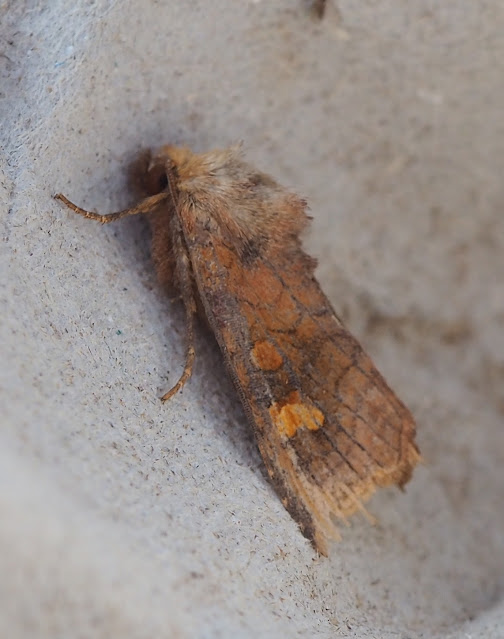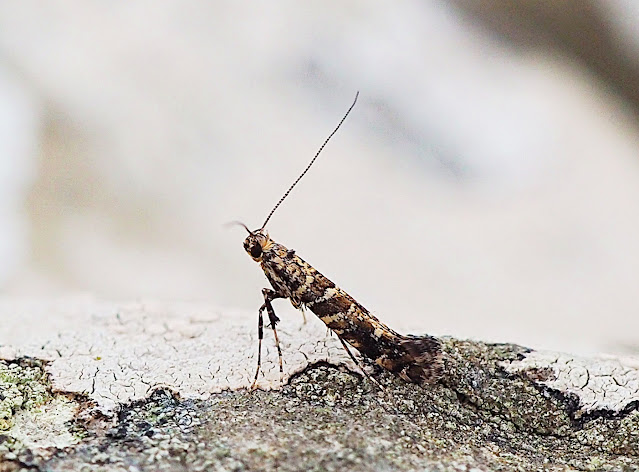We had a few days South as we took younger daughter back to university and managed to find a place to stay in Glen Isla. The garden was small, but the owners gave permission for light trapping, and I just happened to have my wee Heath trap with a synergetic in the back of the car. I ran the light trap on three nights with mixed results but a few NFM and a few I see not very often, so a good result.
 |
Picked off the outside of the trap the first night, Zeiraphera ratzeburgiana, Spruce Bud Moth, re-identification thanks MY, this is actually Epinotia tenerana, (Nut Bud Moth) NFM all the same. |
 |
Thanks to SS for identifying this for me, Mouse Moth, also NFM, I think, there are just a very few records for Orkney.
|
I caught a few Lesser Yellow Underwing, which are also very uncommon in Orkney.
 |
| Lesser Yellow Underwing, a very varied species, I caught one in Orkney the evening we returned, strikingly different. |
|
 |
Lesser Yellow Underwing, NFS, Harray, very like the illustration of "Hebrides specimen" in Townsend and Waring.
|
Not much else of note on the first night, although I had to consult again on a very different looking Square-spot Rustic, the Orkney ones are very consistent, and a good number caught in VC90 looked just the same, but this one looked quite different.
I expect them to look more like this...
 |
Square-spot Rustics.
|
One of the reasons I'm not so keen on Noctuids is the large variations within species, you think you know one, but actually, you don't.
The predominant grass moth was Agriphila tristella (actually the only grass moth). Agriphila straminella is the main species in Orkney, pretty much finished for the year now.
 |
Agriphila tristella.
|
other species caught were: Dark Arches, Antler, Smoky Wainscot, Large Yellow Underwing, Rosy Rustic, Burnished Brass, Small Square-spot and Common Carpet.
The following evening was a bit of a waste of time, just seven species, it was a cold night and the only thing new was a Cnephasia, which for some reason I didn't take to dissect, it looked like C. asseclana though, so that's most likely what it was.
However, the third night produced good conditions and a more varied selection and included some species I see very rarely and a nice NFM.
 |
Black Rustic, two, a nice fresh one and a slightly worn one.
|
 |
Bird-cherry Ermine.
|
 |
Pine Carpet
|
 |
Spruce Carpet.
|
Best capture though was this rather tatty Ear, Amphipoea agg
I took the specimen as it's one that should be identifiable with dissection.
 |
Crinan Ear, Amphipoea crinanensis. The easiest of the four to ID on dissection, a male. NFM.
|
A Buff Footman was also a nice one, for some reason this is the species I tend to catch when I come south. The hind wing is grey.
 |
Grey hind wing.
|
 |
Buff Footman.
|
Additional species caught were:Autumnal Rustic, Common Marbled Carpet, Eudonia angustea, Eudonia pallida.
There were various other things in the trap of course including four species of beetle, plenty of caddis, which I mostly chose to ignore, a collembola, a slug and a selection of craneflies which I also allowed to conveniently escape.
 |
Nicrophorus investigator.
|
However, I did find some caterpillars on the side of the cottage, shinning up the wall in the dark from their daytime hidy-hole in the Petunia pots. These took a bit of research but thanks to CH and SL and Lepiforum I found an excellent match with Red-necked Footman - NFM.
 |
Red-necked Footman.
|
The other rather excellent insect from the trip was a bee, Louise found a moribund Bombus monticola on the day we went up Monamenach, and I subsequently saw two more, pretty sure I've not seen this species before, or at least not noticed it.
 |
Bombus monticola.
|
Monamenach is apparently about the easiest Corbett as the starting point for the walk is quite high up. It is a pretty uninspiring tramp to the top, up a trackway for much of it, which the hound also managed. However, the panoramic views from the top are indeed worth the effort.
 |
At the top.
|
Through the week I did my usual bird recording, Red Kite from the garden was nice. An Osprey, more kites and a likely, but just glimpsed, Gos were also enjoyed. A young Sparrowhawk terrorised the garden Blue Tits one morning, and then sat on the table a couple of feet from us. Loch of Lintrathen has a nice wetland and there were migrant waders, Greenshank, Green Sand, Ruff, and rather suprisingly a Knot. There were also plenty of Emerald Damselflies at this site.
 |
Sparrowhawk, 1cy male I thought.
|
 |
Lestes sponsa.
|




















































